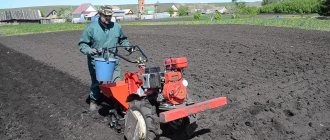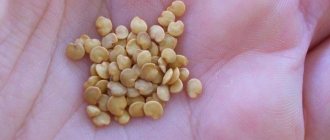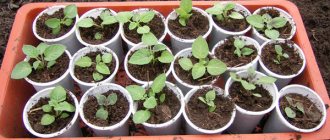Advantages and disadvantages
Not all gardeners welcome digging potatoes with a walk-behind tractor. The reason is the high risk of damage to potato tubers during digging. Such fears are not unfounded. Inept use of a motor cultivator when digging potatoes increases the number of cut root vegetables. The reason is incorrect configuration of the equipment.
But despite the high percentage of defects, the use of technology in the harvesting process has its advantages:
- Mini tractors for digging potatoes have a very simple design. Therefore, managing them is easy to understand after spending a little time. The main part of such a cultivator is a potato digger, made up of a plow and an upper fan.
- The cultivator is easy to set up for a person with minimal experience. To ensure that the tubers are not damaged during harvesting, the depth of the plow, which extracts the root crops to the surface, is adjusted.
- Physical activity is greatly reduced, since it is enough to operate the equipment.
- The harvesting speed increases several times compared to manual digging.
There is only one drawback when digging up potatoes with a walk-behind tractor - the high price of the equipment. Therefore, such a device is usually purchased by vegetable growers who plant potatoes over a large area every year. If the area for potatoes does not exceed 2-3 acres, it is unprofitable to buy a walk-behind tractor for processing them.
Advantages of mechanical cleaning
You can dig up potatoes manually or mechanically. However, since nightshades are most often dug in the fall, when weather conditions often change, gardeners are trying to speed up the harvesting process and use special technologies.
Mechanical harvesting of nightshade crops has the following types of advantages:
- the harvesting process is carried out quickly;
- using a mini tractor allows you to collect large areas of plantings without loss;
- tubers are less injured during harvesting;
- during harvesting a person does not make any physical effort;
- The collection of tubers in bags is carried out quickly.
Also, using a walk-behind tractor for harvesting allows you to prepare the area for further work. Using a walk-behind tractor, the gardener removes excess tops and weeds.
Correct setup of the walk-behind tractor
Harvesting potatoes with a walk-behind tractor is performed in the same way regardless of the design features of the driving mechanism. The machine is used here only as a draft force. Its power only affects the speed of tuber extraction. The most important adjustment is made on the towing mechanism.
The easiest way to dig up potatoes is with a fan plow. Trimming the soil layer is carried out with a pointed nose. The tubers then fall onto curved rods. As a result, they all end up on the soil surface.
The depth of the plow is adjusted using holes drilled on the potato digger bar. The towing mechanism can be moved up and down on them. Additionally, you can change the angle of the plow. The larger it is, the deeper the plow will go into the ground while the walk-behind tractor is moving.
Important! When adjusting the angle of inclination of the plow, it is necessary to find a position so that it does not go too deep into the ground. This will lead to equipment slipping. If the depth is insufficient, the root vegetables will be cut. Some of the tubers will remain in the ground.
For more convenient work, a device is used that changes the interval between the wheels. With its help, the row spacing can be adjusted when planting potatoes. This makes digging potatoes with a walk-behind tractor easier. If the wheels are spread wide, the risk of root crops rolling under them is reduced.
How to dig potatoes with a walk-behind tractor
Before harvesting, the area is cleared of debris, all grass is removed and fallen leaves are removed.
How to remove tubers
After adjusting the plow, make a test pass:
- The walk-behind tractor only goes a few meters along the row.
- They collect the potatoes and inspect them carefully. If the equipment is configured correctly, the tubers will not be damaged.
- If cut and rubbed potatoes are found, the digging depth is increased. Make a second pass and check the dug tubers again.
Some gardeners do not want to spend time setting up equipment. They are the ones who complain that the walk-behind tractor spoils the harvest. Correct adjustment ensures ease of operation.
After the walk-behind tractor passes, all the potatoes rise to the surface of the soil and are collected manually.
Digging features
Passes with a walk-behind tractor are carried out through a row: first, odd rows are processed, then even rows. This is done so that the dug up tubers that fall into the distance between the rows are not damaged by the wheels of the walk-behind tractor.
Important! If you dig up potatoes row by row, the equipment will begin to move to the side and it will become difficult to hold it.
When the work is done correctly, a walk-behind tractor with a potato digger allows you to process up to 6 acres of land in 1 hour. Digging takes no more than 20 minutes, then the potatoes are collected by hand. This is an approximate time, as it directly depends on the number of people involved in cleaning.
Types of potato diggers
In combination with a driving mechanism, different types of trailed potato diggers are used. Gardeners harvest crops using simple homemade diggers or factory-made models. The latter can dig and collect tubers on their own. All that remains is to take the harvest to the right place.
Factory
Typically, vegetable growers prefer to use factory-made potato diggers for harvesting. They are of higher quality, more convenient to use, and easy to manage and configure. There are three main types of towbars:
- Vibrating potato diggers consist of a vibrating sieve and a ploughshare. First, the soil layer along with the tubers is pryed up using a plowshare. Then it is transferred to a moving grate through which the earth spills down. The root crops remaining on it roll down behind the movement of the trailing mechanism. This potato digger is very effective, so it is used in large areas.
- The conveyor potato digger has a similar principle of operation. Here, the layer of soil with tubers is also raised using a ploughshare onto a special table. There the soil is sifted and the crop is placed on top behind the walk-behind tractor. Conveyor-type potato diggers are very reliable and easy to operate.
- Lancet potato diggers are the simplest. Their design does not involve moving parts. Using a rod, a bayonet shovel is attached to the walk-behind tractor so that the cutting plane is at a certain angle to remove the soil layer while moving. Thanks to the gaps between the rods, root crops are retained.
Homemade
If you have the skills and materials, you can make a simple potato digger with your own hands. The advantage of their design is their low cost and wide range of customizable parameters.
May be interesting Potato variety Elizaveta: description and characteristics, reviews “Charoit” potato: characteristics and yield When to dig potatoes according to the lunar calendar in 2020
Making a potato digger step by step:
- A rectangular frame is made from a pipe with a square cross-section using a welding machine.
- A piece equal to half the length of the frame is cut from the same square pipe. It is used to weld the base to the traction structure.
- The wheel axle is welded on the back side of the frame.
- Ralo is made from metal sheets. Weld it on the bottom of the frame.
- A pitched board is made from a metal plate by welding 10 identical rods to it. It is mounted at the same level as the rafter on the frame of the digger.
Timing for digging up potatoes
It is impossible to name specific harvest dates, since some gardeners dig up tubers on their plots in July to get young potatoes, while others wait until September.
In addition, there are several factors that influence the timing of harvesting vegetables: variety, time when the potatoes were planted, caring for the bushes throughout the season and weather conditions.
It should be borne in mind that the shelf life of young potatoes is no more than three to four days. Over a longer period, the thin skin loses its protective functions, and the tubers may be affected by rot or various diseases.
Recommendations for selection
For agricultural work, you can purchase a walk-behind tractor or a walk-behind cultivator. Devices of the first type are more powerful; they are capable of performing many functions. The power of motor cultivators is less. They are usually used to loosen the soil. If necessary, they can be used as a traction mechanism when working on soft ground.
When choosing a potato digger and walk-behind tractor, use the following recommendations:
- if it is necessary to process large areas, choose models with high power;
- It is preferable to use a factory-made potato digger as it is safer;
- The walk-behind tractor and potato digger must be sized to each other, otherwise damage to the tubers may occur;
- choose devices with the ability to deeply immerse the plant so that damage to the tubers is minimal.
Important!
When purchasing a digger for an existing walk-behind tractor, take into account its type. For light cultivators, the “Bison” or “Agro” models are suitable. For walk-behind tractors with high power, diggers KVM-3 or KVM-1 are purchased. With such devices you can dig up tubers from a depth of 25 cm or work in dense soil.
Choosing a walk-behind tractor and its parameters
The technology speeds up the collection of vegetables even in small areas. On potato plantations you simply cannot do without it.
Buying a walk-behind tractor saves the gardener from hiring a tractor every year for plowing. The main thing is to choose the right device.
Powerful or weaker
The more powerful the device, the more productive it is, but more expensive. Lightweight equipment is much more maneuverable, so it is convenient for processing small areas.
The table shows the dependence of the device’s power on the size of the garden:
| Plot size | Walk-behind tractor power, l. With. | Working width, cm |
| up to 50 acres | 4 | 80 |
| up to 2 hectares | 6 | 90 |
| up to 5 hectares | 9 | 100 |
It is advisable to choose a device with a small power reserve. The engine will last longer if it is not overloaded. It is important to consider the type of soil you will be working on.
For different types of land, choose a device with a suitable weight:
- for light soils - 50–70 kg;
- for clayey soils - 80–120 kg;
- for large fallow areas - 120–150 kg.
Instructions for digging potatoes with a walk-behind tractor
Numerous videos show how easy and fast it is to dig potatoes with a walk-behind tractor. But some beginners still have difficulty handling such equipment. Therefore, before starting work, it is necessary to learn how to properly use this equipment.
Before digging potatoes, the area is cleared of debris and grass. Then the harvest begins. Dig up root crops through the row. This is necessary to prevent damage to the tubers by the wheels of the walk-behind tractor. In addition, this makes the equipment easier to control.
Algorithm of actions when digging with a walk-behind tractor:
- the potato digger is adjusted to the characteristics of the site;
- walk 2 m of the first row and carefully examine the result, if necessary, make additional adjustments so that the tubers can be removed completely, without damage;
- walk another 2 m row and again inspect the result of the work.
The walk-behind tractor should move at low speed. Then the likelihood of damage to root crops is reduced. If the rake depth is set correctly, 90% of the tubers will be removed without damage.
Tips and tricks
In order for the potato digger to cope with its tasks properly, adhere to the following recommendations:
- Be sure to carry out adjustments before starting work.
- The power of the device must be sufficient, especially when it is used for large areas.
- The size of the digger is selected so that it matches the size of the walk-behind tractor. If it is too large, it will damage the crop.
- To keep losses to a minimum, make a test pass and adjust the diving depth.
Reviews
Sergey, 48 years old:
Our potatoes occupy a small area, only 6 acres. But I still don’t want to waste energy and dig it with a shovel. Therefore, we regularly use a walk-behind tractor for harvesting. Just an hour of work and all the potatoes were dug up. Real saving of time and effort.
Anastasia, 36 years old:
A potato digger greatly simplifies the work of harvesting the potato crop. I especially like that you don’t have to poke around in the ground looking for tubers. They are all on top, all that remains is to collect them in bags.
Gardeners spend a lot of time and effort on harvesting potatoes. Walk-behind tractors and walk-behind cultivators make this work much easier. With their help, harvesting root crops goes several times faster.
Seed selection and harvest preservation
After all the potatoes have been dug up, they should be dried thoroughly before storing. This can be done on a sunny, warm day. Presence of wind is desirable. Under no circumstances should potatoes be poured into a lighted, open place: a toxic substance, solanine, may accumulate in it. The best option is to pour the tubers under a canopy, on the south side.
It is recommended to dry potatoes in groups. Drying one batch will take no more than 4-6 hours. During the process, you need to turn the tubers on the other side so that the potatoes are well dried on all sides. Next, the crops must be taken into the bin in groups. The depth of the room is standard - two, three meters. The walls should be whitewashed; it is advisable to renew the whitewash every year. The product must be stored in ordinary wooden boxes, new and dry.
You should pour the tubers carefully so as not to damage them
Note! If you store damaged, undried vegetables, rot may occur. Each batch of potatoes needs sorting
There should be open access to all groups to check the condition of the fruit if necessary. The required storage temperature for tubers is +2-3 degrees, and the humidity level is 85-90%
Each batch of potatoes needs sorting. There should be open access to all groups to check the condition of the fruit if necessary. The required storage temperature for tubers is +2-3 degrees, and the humidity level is 85-90%.
After putting the potatoes into storage, you need to carefully inspect the area: the remaining weeds and tops can be used to create compost. Only healthy tops and dry plants without seeds are suitable. Unhealthy tops are burned.
Growing a crop is half the battle
It is equally important to assemble it in a timely manner and put it away for storage. It is worth listening to the recommendations of experienced gardeners
This will help you get a good harvest and keep the potatoes safe and sound.
How to properly configure equipment?
Before you start harvesting the cultivator, it is pre-configured. When setting up equipment for collecting potato root crops, special attention is paid to adjusting the plow, which is responsible for digging up potatoes.
First, the distance the plow goes deep into the soil when digging is adjusted. It is enough to set the depth equal to the size of one shovel bayonet. If you set a smaller distance, then when digging potatoes out of the ground with a motorized cultivator, the root crops will be damaged.
The depth regulation is controlled by bolts located between the lock and the plow stand. After loosening the bolts, you can move the plow down or up yourself.
After adjusting the depth, the angle of inclination of the field board relative to the ground surface is adjusted. To adjust the angle, you will have to use a screw handle. When adjusting, the handle is twisted until the board rests completely on the ground. Then the handle is twisted in the opposite direction so that its back part rises 2–5 cm above the ground.
Why is it sometimes necessary to speed up harvesting?
Garden owners know that manually harvesting potatoes under a shovel is a complex process that takes a lot of time. First, you have to remove all the weeds and large dry potato tops from the garden. Next, they dig up the ground with a shovel or pitchfork, throwing the tubers to the surface. You still need to bury the holes behind you, so as not to sprinkle rolled potatoes dug from the next row into them.
Manual operation occurs over more than one day, which is especially unacceptable during the approach of bad weather. With the onset of the rainy season, undug tubers begin to germinate again. Many potatoes rot or change their taste. If the crop is dug up after rain, all the tubers covered in mud will have to be washed, which is why they are poorly stored in the cellar in winter. A motor cultivator or walk-behind tractor helps to avoid all problems with harvesting and speed up this process.
Important! The only advantage of manual harvesting of potatoes is the absence of costs for the purchase of a motor cultivator and fuel for it. .











